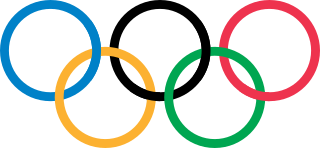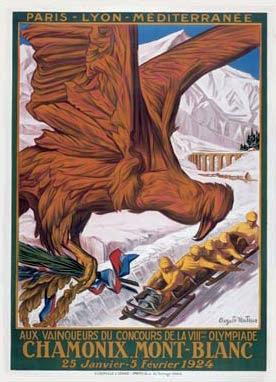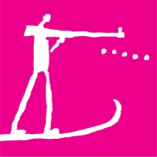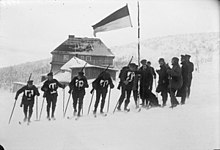
The biathlon is a winter sport that combines cross-country skiing and rifle shooting. It is treated as a race, with contestants skiing through a cross-country trail whose distance is divided into shooting rounds. The shooting rounds are not timed per se, but depending on the competition, missed shots result in extra distance or time being added to the contestant's total.

Skiing is the use of skis to glide on snow. Variations of purpose include basic transport, a recreational activity, or a competitive winter sport. Many types of competitive skiing events are recognized by the International Olympic Committee (IOC), and the International Ski Federation (FIS).

Shooting sports is a group of competitive and recreational sporting activities involving proficiency tests of accuracy, precision and speed in shooting — the art of using ranged weapons, mainly small arms and bows/crossbows.

The Winter Olympic Games is a major international multi-sport event held once every four years for sports practiced on snow and ice. The first Winter Olympic Games, the 1924 Winter Olympics, were held in Chamonix, France. The modern Olympic Games were inspired by the ancient Olympic Games, which were held in Olympia, Greece, from 776 BC to 394 AD. The Baron Pierre de Coubertin of France founded the International Olympic Committee (IOC) 1,500 years later in 1894, leading to the first modern Summer Olympic Games in Athens, Greece in 1896. The IOC is the governing body of the Olympic Movement, with the Olympic Charter defining its structure and authority.

The 1948 Winter Olympics, officially known as the V Olympic Winter Games and commonly known as St. Moritz 1948, were a winter multi-sport event held from 30 January to 8 February 1948 in St. Moritz, Switzerland. The Games were the first to be celebrated after World War II; it had been twelve years since the last Winter Games in 1936.

The 1924 Winter Olympics, officially known as the I Olympic Winter Games and commonly known as Chamonix 1924, were a winter multi-sport event which was held in 1924 in Chamonix, France. Originally held in association with the 1924 Summer Olympics, the sports competitions were held at the foot of Mont Blanc in Chamonix, and Haute-Savoie, France between 25 January and 5 February 1924. The Games were organized by the French Olympic Committee, and were originally reckoned as the "International Winter Sports Week." With the success of the event, it was retroactively designated by the International Olympic Committee (IOC) as "the first Olympic Winter Games".

The 1992 Winter Olympics, officially known as the XVI Olympic Winter Games and commonly known as Albertville '92, was a winter multi-sport event held from 8 to 23 February 1992 in and around Albertville, France. Albertville won the bid to host the Winter Olympics in 1986, beating Sofia, Falun, Lillehammer, Cortina d'Ampezzo, Anchorage, and Berchtesgaden. The 1992 Winter Olympics were the last winter games held in the same year as the Summer Olympics. The Games were the fifth Olympic Games held in France and the country's third Winter Olympics, after the 1924 Winter Games in Chamonix and the 1968 Winter Games in Grenoble. This games was the first of two consecutive Olympic games to be held in Western Europe, preceding the 1992 Summer Olympics in Barcelona, Spain.
1924 in sports describes the year's events in world sport.

Olympic sports are contested in the Summer Olympic Games and Winter Olympic Games. The 2020 Summer Olympics included 33 sports; the 2022 Winter Olympics included seven sports. Each Olympic sport is represented by an international governing body, namely an International Federation (IF).

The 1924 Winter Olympics, officially known as the I Olympic Winter Games, and known at the time as Semaine Internationale des Sports d'Hiver, was a winter multi-sport event held in Chamonix, France, from 25 January to 5 February 1924. Norway topped the table, collecting seventeen medals in total, including four gold, three of which were won by Thorleif Haug in the Nordic combined and cross-country skiing events. Norway also achieved two podium sweeps, winning all three medals in both the 50 km cross-country skiing and the Nordic combined. This remained a record at the Winter Olympics until 2014.
At the 1924 Winter Olympics, in Chamonix, France, a military patrol competition was held. The Olympic results database lists the official medal winners for the event, as does the Official Report (1924), yet several sources have incorrectly counted this competition as a demonstration event only. The event was also demonstrated in 1928, 1936, and 1948, but those results are still considered unofficial. A full 36 years would pass before the modern version of the sport, biathlon, became an official Winter Olympic sport. The official website of the IOC now treats Men's Military Patrol at the 1924 Games as a separate discipline, without mixing it with the sports of Skiing or Biathlon. However, the 1924 Official Report treats it as an event within the sport of skiing.

Shooting sports have been included at every Summer Olympic Games since the birth of the modern Olympic movement at the 1896 Summer Olympics except at the 1904 and 1928 games.

The biathlon competition at the 1994 Winter Olympics were held at the Birkebeineren Ski Stadium. The events were held between 18 and 26 February 1994.
Biathlon at the 1960 Winter Olympics consisted of one biathlon event, held at McKinney Creek Stadium, Tahoma, California. The event occurred on 21 February 1960. This was the first appearance of modern biathlon in the Olympic Games. In 1924, a military patrol event was held. Some sources do not include this military patrol race as an Olympic event, but the IOC considers it an event within biathlon.
At the 1948 Winter Olympics in St. Moritz, Switzerland in 1948, the last military patrol competition was held as a demonstration sport. This was in part to the aftermath of World War II, which decimated Europe. This sport would be superseded by the biathlon competition which debuted at the 1960 Winter Olympics. The cross-country ski run was not prepared, and was made by the leading Swiss team. The Czechoslovak participant Karel Dvořák described the weather of the day as extremely mild with temperatures of about 0 °C at the starting point at the upper cableway station on top of the Corviglia in the morning. The participants wore military equipment, 10 kg of baggage on the back and a military rifle. Only the officers, the patrol leaders, had pistols and did not compete in shooting. At the shooting range they had to shoot on three rubber balloons at a distance of 150 m. Every hit gave a bonus of 1 minute for the team.

Biathlon debuted at the 1960 Winter Olympics in Squaw Valley, California with the men's 20 km individual event. At the 1968 Winter Olympics in Grenoble, the men's 4 × 7.5 km relay debuted, followed by the 10 km sprint event at the 1980 Winter Olympics in Lake Placid, New York. Beginning at the 1992 Winter Olympics in Albertville, women's biathlon debuted with the 15 km individual, 3 × 7.5 km relay, and 7.5 km sprint. A pursuit race was included at the 2002 Winter Olympics in Salt Lake City. The top 60 finishers of the sprint race would qualify for the pursuit event. The sprint winner starts the race, followed by each successive biathlete at the same time interval they trailed the sprint winner in that event. At the 2006 Winter Olympics in Turin, a mass start was introduced where the top 30 biathletes from the previous four events were allowed to start together for the competition.

Finland first participated at the Olympic Games in 1908, and has sent athletes to compete in every Summer Olympic Games and every Winter Olympic Games since then. Finland was also the host nation for the 1952 Summer Olympics in Helsinki. Finnish athletes have won a total of 305 medals at the Summer Games, mostly in athletics and wrestling. Finland has also won 175 medals at the Winter Games, mostly in nordic skiing events.

The 2016 Winter Youth Olympics, officially known as the II Winter Youth Olympic Games, took place in and around Lillehammer, Norway, between 12 February and 21 February 2016. They were the fourth Youth Olympic Games and the second winter edition. Lillehammer was awarded the games on 7 December 2011 as the only candidate. The games reused venues from the 1994 Winter Olympics; this made Lillehammer the first city to host both regular and Youth Olympics. In addition to Lillehammer, sports were contested in Hamar, Gjøvik and Øyer.

Competitive cross-country skiing encompasses a variety of race formats and course lengths. Rules of cross-country skiing are sanctioned by the International Ski Federation and by various national organizations. International competitions include the FIS Nordic World Ski Championships, the FIS Cross-Country World Cup, and at the Winter Olympic Games. Such races occur over homologated, groomed courses designed to support classic (in-track) and freestyle events, where the skiers may employ skate skiing. It also encompasses cross-country ski marathon events, sanctioned by the Worldloppet Ski Federation, and cross-country ski orienteering events, sanctioned by the International Orienteering Federation. Related forms of competition are biathlon, where competitors race on cross-country skis and stop to shoot at targets with rifles, and paralympic cross-country skiing that allows athletes with disabilities to compete at cross-country skiing with adaptive equipment.














